ASUS UX31A: Putting the Ultra in Ultrabooks
by Jarred Walton on August 28, 2012 9:00 AM EST- Posted in
- Laptops
- Intel
- Asus
- Ivy Bridge
- Zenbook Prime
- Ultrabook
ASUS UX31A: General Performance
Next up is our overview of general performance, and honestly outside of the laptop overview and LCD characteristics this is probably the most pertinent aspect of how the UX31A behaves in everyday use. You typically don’t buy an Ultrabook because you want the fastest laptop on the planet or for serious gaming. Those duties are for larger laptops that can house discrete GPUs and quad-core processors. Ultrabooks are about portability and everyday tasks like running Office, surfing the Internet, checking email, etc.—only they’re hopefully more responsive than regular laptops thanks to their SSDs. Here’s how the UX31A compares to other recently reviewed Ultrabooks, including the prototype Ivy Bridge Ultrabook from Intel.
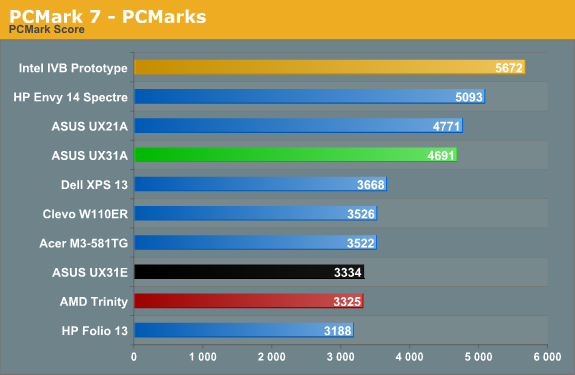
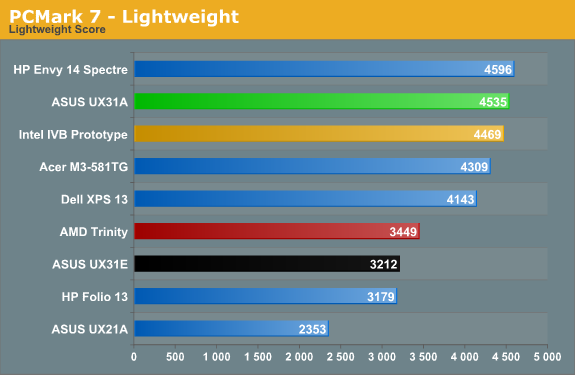

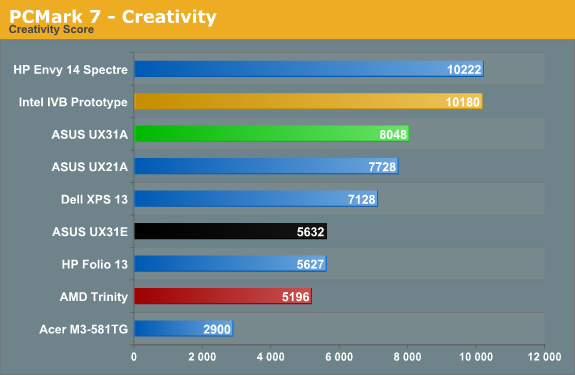
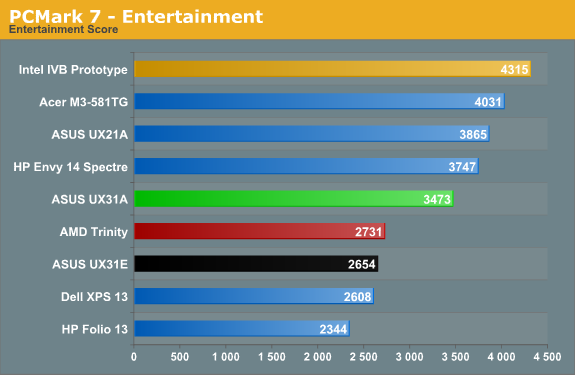
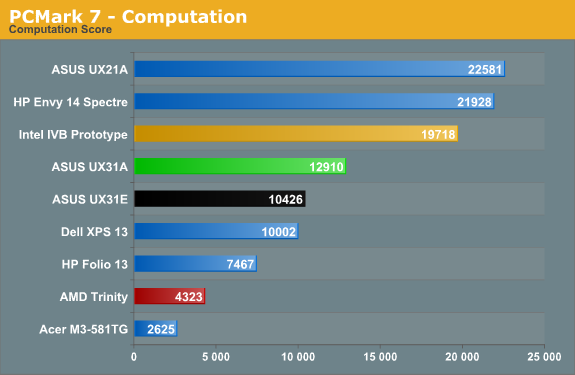
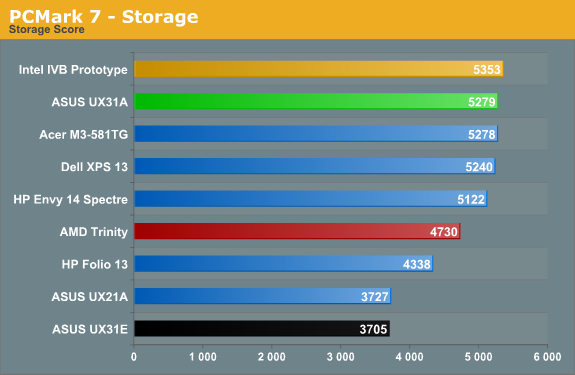
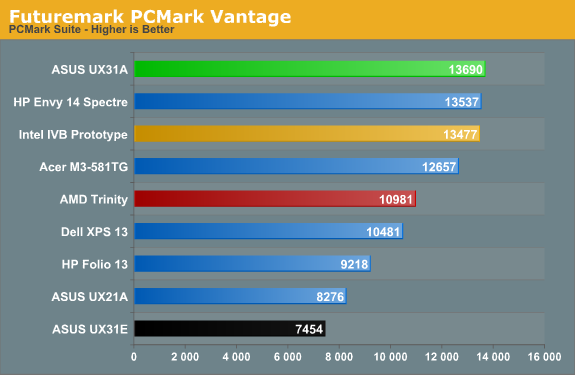
We’re looking at a faster i7-3517U processor compared to the i5-3427U in the last IVB Ultrabook, so naturally some of the scores are higher. PCMark 7 is extremely sensitive to storage performance for most of the tests, and the SF-2281 based SSDs are among the fastest out there (SandForce firmware issues notwithstanding, though I haven’t personally experienced any issues). But if the UX31A sports the fastest ULV processor we’ve tested so far and one of the fastest SSDs, why doesn’t it dominate all of the charts? The problem appears to be with the Intel GPU drivers; other IVB Ultrabooks and laptops have scored in the 20,000+ range in the Computation suite, thanks to Quick Sync, but the UX31A only manages just under 13K. ASUS shipped the UX31A with Intel’s latest 2761 driver set, and while I’ve seen good scores with those drivers I’ve also seen sub-par scores; this appears to be a case of the latter, and it brings down the Computation, Creativity, and Entertainment scores, which in turn affects the overall score as well. Don’t let those minor differences concern you, though: this is right up there with the fastest Ultrabooks.
PCMark Vantage doesn’t utilize Quick Sync, leveling the playing field quite a bit, and you can see that the UX31A tops that chart. Obviously, the difference isn’t all that great, but we wouldn’t expect it to be. The i7-3517U comes with a base clock just 100MHz higher and a max Turbo clock that’s 200MHz higher than the i5-3427U, and as a system benchmark we don’t expect to see that much of a spread in PCMark. Now let’s see what happens with the other benchmarks.
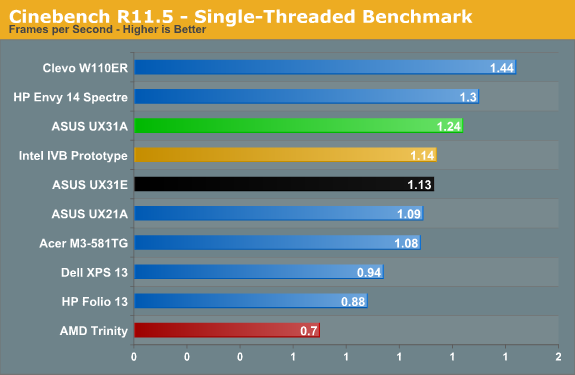
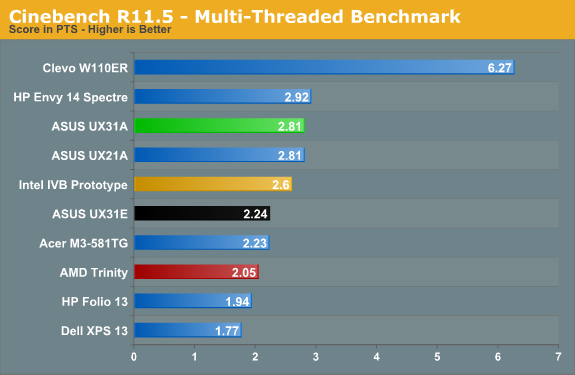
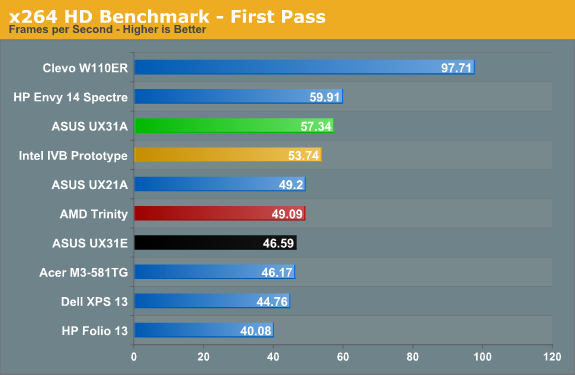
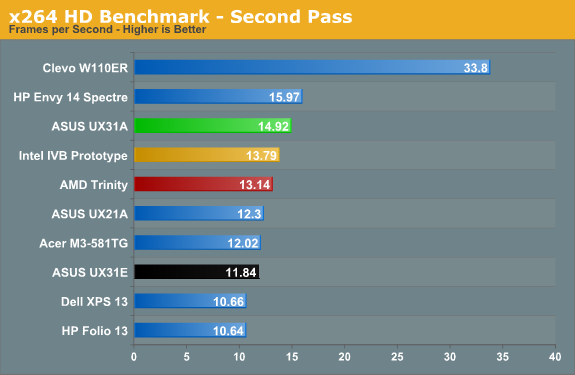
Moving on to the CPU testing side of things, the i7-3517U performs right where you’d expect. A dual-core ULV processor will never match the likes of 45W quad-core Ivy Bridge CPU for raw computational power, but if you’re only doing typical office and Internet related tasks, along with consumption of multimedia, it’s not really a problem. There are definitely applications that will benefit from more CPU performance, but things like 3D rendering (Cinebench) and video editing are only used by a relatively small percentage of users; if you have a desktop in addition to a laptop, that’s likely where you’re going to be doing such tasks. The i7-3517U ends up just slightly faster than the i5-3427U, and there’s really not much of a benefit to the upgrade. Either you can live with ULV performance and the i5 chips, or you’ll need more than the i7 ULV parts can provide.
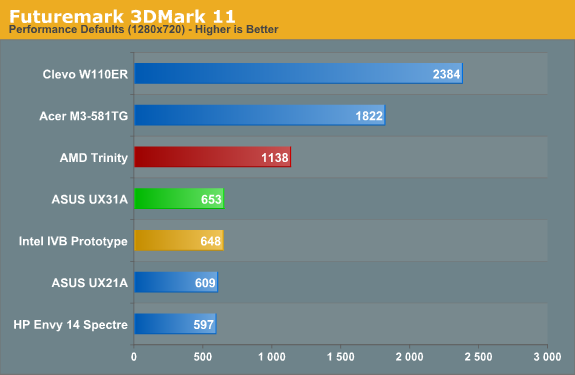
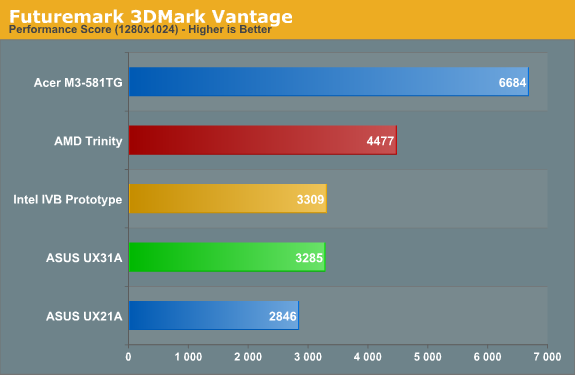
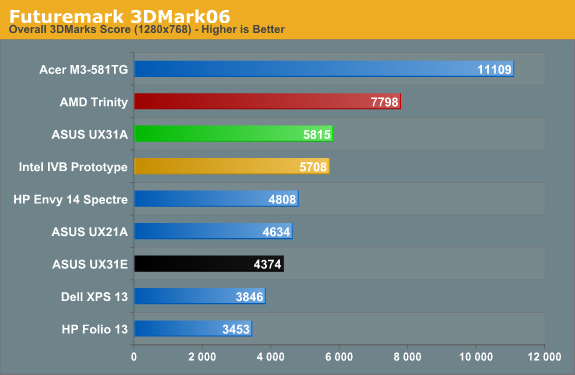
Wrapping up with a quick look at graphics performance, while HD 4000 is certainly a big step up from HD 3000—which in turn was an even bigger step up from Arrandale’s HD Graphics—it’s still nowhere near matching even midrange GPUs like the GT 640M. Ultrabooks are okay for most casual games, but demanding titles will prove too much for the HD 4000, especially when it has to operate within a 17W TDP. If you want an Ultrabook that has a bit more gaming potential, we’d suggest looking at ASUS’ UX32VD (it includes a switchable GT 620M dGPU) or Acer’s updated M5 Ultrabook (with a faster GT 640M LE dGPU). But let’s not base that off of just 3DMark results….










106 Comments
View All Comments
JarredWalton - Tuesday, August 28, 2012 - link
I didn't see any stickers, so you should be able to remove the HSF with a bit of effort. I didn't try to do this but the screws are easily accessible. I should note that I tried to disconnect the battery plug and gave up for fear of breaking something, though, so maybe it won't be so easy. LOLj_c - Tuesday, August 28, 2012 - link
"and stay away from the SanDisk U100 if you want decent SSD performance"More details on that particular issue would be nice.
Do you know a way to distinguish between these two models?
JarredWalton - Tuesday, August 28, 2012 - link
AFAIK, ASUS is not shipping the U100 any longer because of the performance issues. You can see where the UX31E and UX21A (with U100) rate in the PCMark 7 Storage suite -- basically the slowest SSD solution we've tested recently. What I don't know is whether ASUS figured out something with the ADATA SF-2281 firmware; I never experienced errors, but the BSOD issue still remains on some laptops/desktops.j_c - Thursday, August 30, 2012 - link
Very interesting, because over here in Germany, it seems the Sandisk model is the only one available. One commenter on amazon.de cites a call by Asus Customer Support, that no ADATA models will be available for now.JarredWalton - Saturday, September 8, 2012 - link
Apparently there are plenty of U100 equipped units shipping; I've updated the conclusion.Shadowmaster625 - Tuesday, August 28, 2012 - link
Can anyone make an educated guesstimate on how much a typical ultrabook would cost if it included this specific display, only a 128GB SSD, 4GB of RAM and the cheapest trinity A8?JarredWalton - Tuesday, August 28, 2012 - link
How much to make or how much it would sell for? In terms of BoM costs, it would probably be around $100 less than the Core i5 version ASUS is selling right now. Retail pricing is the real question. Right now, HP's Sleekbook 6z-1000 sells for $225 less than the Intel i5-3317U variant, but that's also with the A6-4455M which would be substantially slower than full voltage A8. The A10-4655M ought to be reasonably fast in graphics vs. Intel ULV, but we haven't been able to test it and it's $100 more than the A6 version ($125 less than Intel).The big problem is that no one is making 13.3" AMD-based "sleekbooks" that I know of -- links if you have them, please. And in fact, their AMD Sleekbooks are the worst thing I can think of: a 15.6" 1366x768 display with an ultra-thin form factor. Do people want 15.6" thin laptops that much? I feel most people going for ultra-thin are going to want 14" or smaller.
Actually, the biggest problem is getting someone to make a 13.3" AMD laptop with a premium quality LCD. It's possible in theory, but getting the bean counters to agree to spend $100 more or whatever for a "premium" IPS 1080p display while going with a "budget" AMD APU is a very long shot. Heck, getting premium displays in consumer laptops in general is hard enough -- the 1080p UX21A/UX31A/UX32VD are the exception. Others might follow ASUS' lead in the future, but I expect all the quality LCDs to reside in $1000+ laptops for a while yet.
ReverendDC - Tuesday, August 28, 2012 - link
I understand that SSD is faster, but I would like more mention of the dependability or lack therein of SSD. I am not sure of the warranty on this device, but if it is a year, you may have issues, especially if you move large chunks on and off the drive regularly (as you probably would for movies and music when taking the laptop on travels). Most SSDs have a warranty of three years, and even AnandTech has stated that you should expect about 5 years of storage, but anything more is gravy.I have 15 year old spinning platters that still give data, although there are some bad sectors starting to crop up. Obviously, I am not willing to go backwards, but SSD is not the best use case in every scenario, especially if data fidelity is a top requirement, even if it is much speedier. What we really need is a price cut in SLC modules, which are far more reliable, with better capacity.
That being said....thanks for the great review. Informative as always.
JarredWalton - Tuesday, August 28, 2012 - link
SSD durability is still far greater than five years for all but the most strenuous use cases, so I'm not too concerned about that. If you're constantly writing data to SSDs, you can burn through it faster, but Anand did some testing where he calculated even extreme use cases would still last five years. Five years from now, I suspect other areas of the laptop are likely to be failing (fans, hinges, whatever), and when an SSD runs out of cycles you can still read data off of it.Kristian Vättö - Tuesday, August 28, 2012 - link
As we have stated in numerous SSD reviews, the endurance of current MLC NAND is not a problem for consumer use.